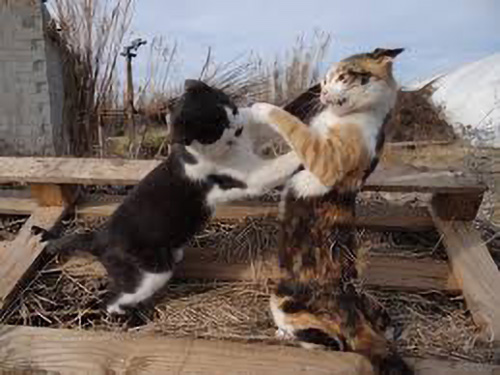Media – Cat Calls
Kitties often Speak Non-Verbally
Question:
Having watched your Facebook Live on cats who fight, I wonder about how do two cats living in a house communicate with each other?
Dr. Nichol:
Cohabitating cats communicate almost continually. Sometimes referred to as socially asocial many could as easily survive alone as live in a feline colony. Genetically programmed for solitary hunting, our kitties are largely wild animals we keep as pets.
Despite their rugged individualism, cats living in groups swap lots of information. They use body postures as signals in most cases. But if they’re pushed by the stresses of indoor confinement they can become fearful, territorial, or hostile, causing them to yell pejoratives at each other with growls, hisses, and snarls.
One method of conversation we humans can’t notice is by pheromones. These substances are released by specialized glands in our cats’ skin and between their toes. Pheromones have no scent. A unique structure at the back of their nasal passages, called the vomeronasal organ, detects these airborne chemicals. Signals are then transmitted via nerve circuits to the feline brain. Decisions are made instantly, allowing the cat to take appropriate action.
Depending on which pheromones are released by the sending cat the receiver may need to prepare for a friendly encounter, a fight or flight situation, or perhaps a romantic interlude (meaningful, although brief). All of this high tech anatomy comes as standard equipment whether a cat lives free or stays sequestered indoors.
I never discourage cat parents from keeping their beloved pets inside but it’s important to realize that by limiting their access to the essentials of a primal feline existence we set them up for significant stress. If they can’t hunt (or at least pretend to stalk and disembowel helpless creatures), roll in the dirt, climb, scratch, and hide everyone can suffer. Toileting behaviors, fighting, diseases of the bladder and skin, not to mention human-directed aggression, are often symptoms of a barren environment. Go to my website, drjeffnichol.com, for a list of feline environmental enrichments. The best way for us to love our cats is to make it easy for them to be all they can be – cats.
Each week Dr. Jeff Nichol makes a short video, blog, or a Facebook Live to help bring out the best in pets. Sign up at no charge at drjeffnichol.com. Dr. Nichol treats behavior disorders at the Veterinary Emergency & Specialty Centers in Albuquerque and Santa Fe (505-792-5131). You can post pet behavioral or physical questions at facebook.com/drjeffnichol or by US Post to 4000 Montgomery Blvd. NE, Albuq, NM 87109.


